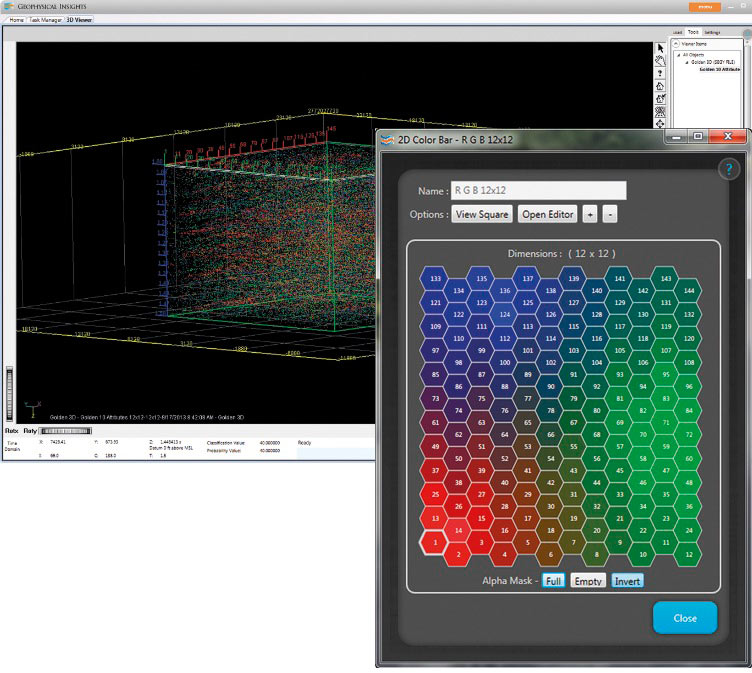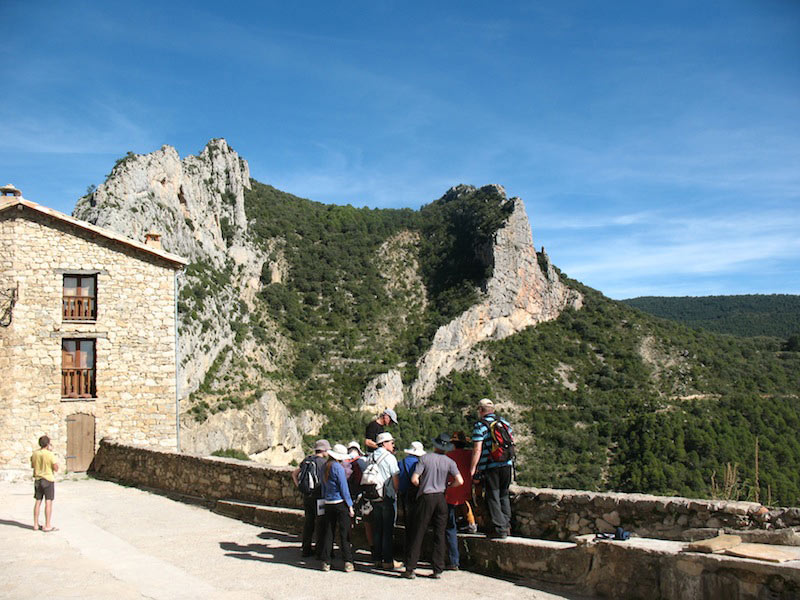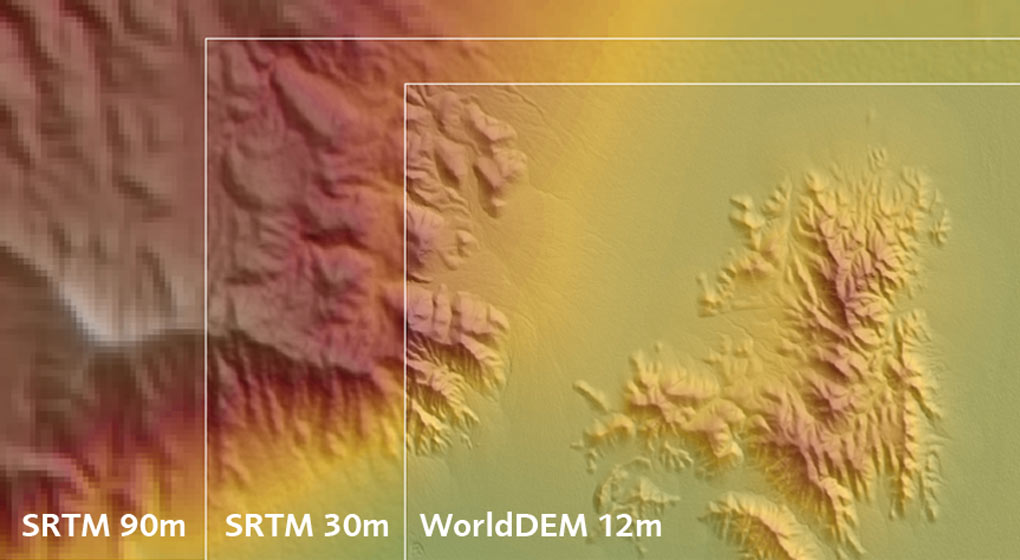Paradise Arrives
 Geophysical Insights, the Houston-based geosciences company, chose SEG 2013 in September to announce the commercial launch of Paradise™, a geosciences analytic software platform.
Geophysical Insights, the Houston-based geosciences company, chose SEG 2013 in September to announce the commercial launch of Paradise™, a geosciences analytic software platform.
Paradise executes and manages workflows based on Self-Organizing Maps (SOM) and Principal Component Analysis (PCA). Geoscientists who have applied Paradise over a two-year period of testing are reporting the potential to reduce risk when exploring for hydrocarbons. The platform enables rapid analysis and comparison of different aspects of seismic and engineering data, while revealing complex and subtle relationships in the data. The suite features guided workflows, interactive world maps, 3D imaging, and a unique 2D colour mapping capability that is integrated and interactive with 3D imaging. Over three years in development, Paradise has a scalable, client-server architecture that has been built to take advantage of multi-processing and to manage very large files. The software suite was designed by a team of geoscientists and interpretation software specialists, and has been thoroughly tested in various geological settings worldwide, including unconventional plays. Paradise enables geoscientists to work independently or collaboratively across an oil and gas enterprise.
South African Shale Permits
 South Africa expects that exploration for shale gas will soon commence in the country, as the Mineral Resources Minister Susan Shabangu recently announced that permits will be issued in the first quarter of 2014. According to the most recent report from the EIA, South Africa has reserves of 390 Tcf of technically recoverable shale gas resources, much of it in the Karoo region in the southern half of the country. Royal Dutch Shell, among others, has applied to explore the region.
South Africa expects that exploration for shale gas will soon commence in the country, as the Mineral Resources Minister Susan Shabangu recently announced that permits will be issued in the first quarter of 2014. According to the most recent report from the EIA, South Africa has reserves of 390 Tcf of technically recoverable shale gas resources, much of it in the Karoo region in the southern half of the country. Royal Dutch Shell, among others, has applied to explore the region.
South Africa lifted a ban on fracking in 2012, and further opened the door to exploitation of the resource by recently publishing regulations on the process, under which drillers will be required to meet American Petroleum Institute standards regarding the type of equipment and chemicals they use. The regulations also include measures to protect wildlife in the region as well as to safeguard water resources.
South Africa currently imports 70% of its crude oil needs, and hopes that by exploring for shale gas reserves it will eventually become more independent in its energy needs, and also greener, as a large percentage of its present supplies come from coal-fired plants.
Unlocking Energy
‘Unlocking Energy through Innovation, Technology and Capability’ is the theme of the 7th International Petroleum Technology Conference (IPTC), which will be held in Doha, Qatar in January 2014 under the Patronage of His Highness Sheikh Tamim bin Hamad Al Thani, Emir of the State of Qatar. IPTC conferences are the largest multi-society, multi-disciplinary oil and gas events in the eastern hemisphere, rotating annually between Asia-Pacific and the Middle East, and are a collaborative effort between AAPG, EAGE, SEG and SPE.
The scope of the conference programme and associated industry activities address the technology and relevant industry issues that challenge industry professionals and management around the world. The 2014 event will include over 100 exhibitors from more than 27 countries – marking a substantial increase from the last conference, in Beijing. There will be a nine-stream conference, featuring 67 technical sessions with over 400 technical presentations, which is expected to draw some 7,000 attendees.
Zagros in the Pyrenees
 Source: GeoScience LtdIn late September 2013 a Zagros Petroleum Geology Workshop was held in Sort, Catalonia, Spain, attended by around 30 people including delegates from major oil companies. The workshop comprised technical presentations from oil companies, consultants and academics working on the petroleum geology of the Zagros Mountains, mainly Iraqi Kurdistan, as well as field trips to examine analogue exposures of fractured carbonates, sharing knowledge in an informal and relaxed setting. There was also plenty of Catalonian culture and local cuisine to experience.
Source: GeoScience LtdIn late September 2013 a Zagros Petroleum Geology Workshop was held in Sort, Catalonia, Spain, attended by around 30 people including delegates from major oil companies. The workshop comprised technical presentations from oil companies, consultants and academics working on the petroleum geology of the Zagros Mountains, mainly Iraqi Kurdistan, as well as field trips to examine analogue exposures of fractured carbonates, sharing knowledge in an informal and relaxed setting. There was also plenty of Catalonian culture and local cuisine to experience.
A range of subjects was covered, from regional scale issues to field appraisal and development. Topics included comparison of the Zagros fold and thrust belt with the Pyrenees, geodynamic analysis of the Zagros foreland and the role of salt tectonics in fold and thrust belts, plus a range of field-specific presentations on fracture, in-situ stress and flow characterisation, dolomitisation and evaluation of fracture porosity for reserve estimations. During the field trips comparisons were made between structures and lithologies in the exposed Pyrenean fold and thrust belt and the Zagros Belt. There was also a visit inside a salt diapir to look at flow textures and shear bands. Carbonate facies from reef to shelf and slope environments were also examined.
This successful workshop, run by GeoScience Ltd and Geoplay Pyrenees Ltd., will be repeated in the next year or two, so keep an eye on geoscience.co.uk and geoplay.cat for information.
World Digital Elevation Model
From 2014 onwards, Astrium Services will be able to offer a worldwide, homogenous digital elevation model, which will be available off-the-shelf for all land masses of the earth including polar regions. WorldDEM™’s resolution and accuracy will surpass that of any satellite-based global elevation model available today and will replace the common data set for SRTM (Shuttle Radar Topography Mission). This new unique elevation data base will open up fresh opportunities for oil and gas projects in terms of accuracy, reliability and availability.
Astrium Services offers a comprehensive portfolio of elevation models thanks to its unique radar and optical satellite constellations, allowing quick acquisition of various input data for either stereo-photogrammetric or radargrammetric generation of digital elevation models. Its GEOElevation Suite consists of different products for serving different requirements, from 30m down to 1m grid spacing, and can support a range of oil and gas projects, from feasibility studies to detailed planning in preparation for field development.
Shell Pessimistic on Unconventionals
Like a number of other majors, Europe’s largest oil company, Shell, entered the US shale gas arena relatively late in the game. Despite having spent at least $24 billion, it has yet to prove a good investment, as the company’s North American upstream business has struggled to turn a profit. In August Shell announced a strategic review of its US shale portfolio, after posting a 60% fall in profit for the second quarter of this year, having had to write-down over $2 billion on the value of its North American liquids-rich shale assets.
Outgoing Shell CEO Peter Voser, in an interview with the Financial Times, admitted that he regretted the ‘huge bet’ on US shale, saying “Unconventionals did not exactly play out as planned… We expected higher flow rates and therefore more scalability for a company like Shell.” He cites the main problem to be US gas prices, which recently hit a 10-year low. “Therefore you are hit with more than $3 billion of depreciation whilst you don’t have the revenues against it,” he added. He believes that much of the US shale boom could be ‘hyped’, and other companies may easily face similar disappointments, and also suggested that shale gas exploration in the rest of the world was at an early stage and may yet yield ‘negative surprises’.





